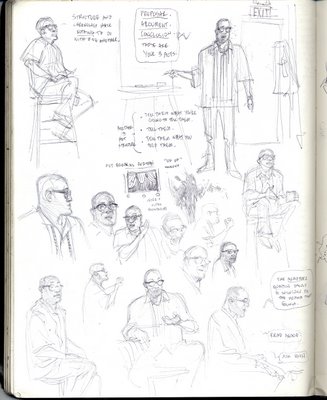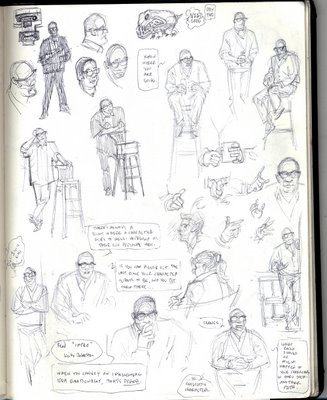The sketches in this blog were done by my friend Derek Thompson who works for Pixar and has sat in on two different seminars of mine. This was his way of taking notes.

A few months ago I had the privilege of teaching my seminar at Pixar. Anyone who knows me knows that there are few modern storytellers I respect as much as I do those at Pixar. They are the best.
I was as nervous as I have ever been in my life. I worship these people. You think I’m kidding, but I cannot express here just how highly I regard their work. At one point while speaking I thought that I might pass out my head was spinning so fast.
All of this tension I was feeling was self-generated, by the way. The people at Pixar could not have been nicer. They were sweet, generous and humble people. Not one person swaggered with pride or puffed their chest out. These were the people who made Toy Story and Toy Story 2, A Bugs Life, Monsters Inc., The Incredibles and (my personal favorite) Finding Nemo and they walked with their feet planted firmly on the ground. And strangest thing of all -- they wanted to hear what I had to say about story construction.
My late friend Scott Tolson used to say after dispensing advice, “but what do I know, I’m just some guy.” That’s the way I felt – I’m just some guy. But they listened to me to see just what I had to teach them. As I said before these are humble people. This is a key element to their success.

I will repeat something from another blog here, but I think it’s appropriate. I was lucky enough to become friends with acclaimed playwright August Wilson a few years before he died. One day, shortly after we had met, I mentioned the story structure class that I teach, and he said that he should take it. I was blown away. I said, “You have two Pulitzers to my zero. Why would you want to take my class?” He told me a story about a guy he knew who had once met the great jazz saxophonist John Coltrane. The man sheepishly mentioned to Coltrane that that he too played the saxophone. Coltrane’s response was, “What can you teach me?”
August wanted to know what I could teach him. In fact, once I was on my cell phone and August approached and hovered around until I got off the phone. He then asked me for advice on his new play. I told him what I thought he should do and he took notes and listened. The man knew that he didn’t have all the answers and wasn’t afraid to seek them out. This was a man at the top of his field, but he showed the same dedication to continued learning that I would later witness at Pixar.

I have seen over and over again that the best people are humble before their craft and don’t lean on their past successes. They are hungry for knowledge and know that they will never reach that elusive goal of knowing everything. One must always move toward the horizon even though the horizon keeps its distance.
5 comments:
It is an interesting balancing act isn't it?
It requires a certain amount of ego just to make something in the first place; to believe that YOUR vision has merit (especially if you have to ask other people to fund it, or work overtime on it), and it also requires ego to defend that material from being undermined by others at times...
Yet, as you say, it also requires humility to prevent complacency, to constantly question your material till it works, and to recognize the difference between an undermining and a contructive criticism....
I like the notes on the sketchpages. It's what you've been talking about in your blog, but distilled down and through someone else's ears.
On the Seven Steps to a better story - what's the context on that? If a story is falling flat, check that you have those points? Make up a story by putting words inbetween (ie, once upon a time there was a woman and every day she had nightmares of aliens, until one day she agreed to go on a ship..)?
And proposal, argument, conclusion - that's a story as basically a really sneaky essay?
Thanks! Your blog always gives me something to think on...
Hello Emma,
Well, I haven’t talked about the seven steps in the blob, but you get the basic idea. But one thing I find is that people like to use these principles to fix a story rather than trying to design a story that works up front. The problem with doing it the other way is that people get attached to things that may not work and try to keep them not matter what. It’s much harder to work that way. So, try to use these steps and the other ideas here to construct your story from the ground up.
As for Proposal, Argument, Conclusion…
One of the things I don’t like about the story gurus is that they often make the concept of story construction complicated when it’s a very simple thing. That doesn’t mean it’s easy to do, but the concepts are simple. And the one thing no one tells you is that we all already understand exactly how stories work because it is the way we talk.
Listen to people talk. Listen to people tell stories to each other. People are always telling stories to each other. The rules about telling a story are the same no matter what kind of story you are telling.
When people talk they will start with a proposal. They will say, “I used to work for the world’s worst boss”. Then they will argue by offering evidence to prove their proposal: “He used to find ways to humiliate people and embarrass them. The guy made us work twelve-hour days with no breaks. One woman had to go to the hospital because the chemicals we worked with were so dangerous and he wouldn’t provide respirators for us.” Then they conclude, “That was the worst job I ever had”.
This is the way people convey information to each other it is not some rule made up by someone. All of these things are observations not rule.
Do not take my word for it, listen to people speak. Listen to them tell stories.
Go back and watch my short documentary on my “Look Inside My Brain” post and see if you can see Proposal, Argument, and Conclusion. They’re there.
I get to work there from time to time and that's the next best thing.
I have been reading your blog backwards from newest to oldest which is something I like to do. To find out where your mind set is currently at and then read backwards how you got there.
Your seven steps is actually put to use by a pixar animator named Austin Madison on youtube doing a seminar on story construction. Looks like your seven steps really hit a homerun with their studio.
Amazing stuff. Will definitely write more really soon, because I have plenty of questions to ask. First, I need to continue my journey reading your blog.
Best,
David perez
Post a Comment